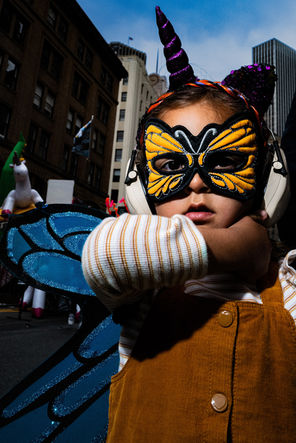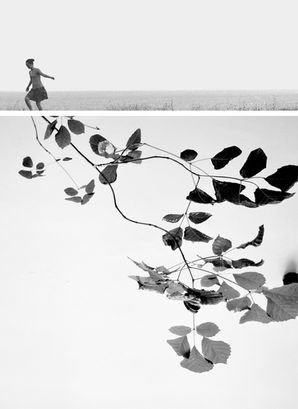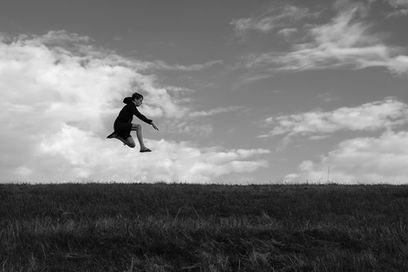
CROSSING THE AVENUE
May 5, 2023
INTERVIEW
PHOTOGRAPHY Juan Sostre
INTERVIEW Bill Lacey
Driven by passion, hunting for the right light, the right expression, the right pose…photographer Juan Sostre’s work is at once recognizable. Bold, in your face, sometimes pretty, sometimes anything but. Filled with boundless energy on the street, he is both a fly on the wall and a bulldog with a flash. Walking with Juan on the street is both exciting and informative. He’s a walking masterclass of street technique. He shoots without hesitation where others might. Raw, edgy, in black and white or color, Juan's street portraits unearth something below the surface that most fail to capture.
Juan is also an amazing curator of street photography. His AVENUE magazine features some of the best street photographers to be found anywhere. His layouts, selections…always the right choices. A magazine that is both fun to flip through yet deserves a spot on the bookshelf along with some of the best photo books in your collection.
Juan shoots with a 28mm lens on a Leica Q2, a Ricoh GR3, and a Fuji X100V, which allows him to get up close and personal. These raw and edgy shots transport the viewer to the very heart of this snapshot in time. If you’re lucky enough to walk with him on the street, you’ll likely see things in a whole new way. So take a walk with us, feast your eyes on his amazing work, and cross the avenue with Juan Sostre.

“My street photography is 80% candid shots and 20% staged. I’m more a hunter than a fisher. Those candid shots are ones in which you can feel the action, the movement, the spontaneous second in life unexpectedly, without necessarily having the subject entirely in the frame or straight.
The 28mm focus length allows me to archive those compositions and get close enough to capture their breath and get my artistic vision. Like a Fly, I'm there seeing you from the point of view that the human eyes are not used to seeing. Maybe in silence, or maybe I make you uncomfortable. I hope the viewer feels and gets that when they see my work. Even when I’m not closer to my subject, I still want to keep that point of view, where my composition makes you see what human eyes are not used to approaching.”
IN CONVERSATION WITH JUAN SOSTRE
THE PICTORIAL LIST: Welcome Juan! To get started please tell our readers about yourself. What would you say first drew you to photography?
JUAN SOSTRE: I studied Image & Design at La Escuela de Artes de Puerto Rico in Old San Juan, where I took a basic photography class, learning how to work in a dark room. It was not until a few years later, in 2007, that my passion for photography started showing up when I needed to start capturing my son's mom's belly. After my son was born, I started capturing those same moments for other families. In 2017, Puerto Rico was ravaged and flooded by Hurricane Maria, and that was when I fled to California to start a new life with my son. I knew I needed extra money since I was without a job and living off my savings for the first few months. Unfortunately, I was forced to sell my camera just to make sure that I had enough money to put food on the table for my son. I was blessed to get a job in an Advertising Agency as Creative lead / Senior Art Director here in California, but it wasn’t until 2020 that I started to find my footing with my work and life.
TPL: What was the first camera you ever held in your hand, brought to your eye, and released a shutter on? What is the camera you use now, and your preferred focal length? Does the equipment you use help you in achieving your vision in your photography?
JS: After using a Canon for years, I bought a Fujifilm X100V 35mm-equivalent focal to use in my day-by-day commute on the train between San Jose and San Francisco. It was that time when the pandemic hit us, and I tried my hardest to keep shooting as much as possible, even shooting portraits at my place with some models, just to get to know my gear. Then I discovered the Ricoh GRIII 28mm through a friend, and I knew from then on that was going to be my preferred focal length.
Since September 2022, I have been shooting with a Leica Q2 28mm as my main camera, and it completely helps me to archive my vision in photography.
TPL: When you take pictures, do you usually have a concept in mind of what you want to shoot, or do you let the images just "come to you," or is it both? Please describe your process.
JS: I never go out with something in mind. I love being spontaneous and a hunter and going with the vibe of the day. Maybe I can make a stop for a few minutes and be a fisher depending on the location and weather.
Most of the time, I keep walking to see what shows in front of me, and then I press the shutter without any hesitation. I barely use my viewfinder to get those points of view. I may look at it or at the screen to see if I got the shot, which I always shoot in black and white and lets me focus on the composition of the frame and don’t get distracted by the colors that I already saw. And never go back home and look at my frames the same day since I don’t want to get influenced by the excitement of my day if it was a good one.
TPL: How do you educate yourself to take better photos?
JS: First, I go out there and shoot as much as possible. Either local in the Bay Area, especially in San Francisco, or travel to other countries to have a different stage and people cultures. Collaborating with my colleagues and having a great conversation about photography with a beer in hand, sharing feedback about our work with respect. Also buying books and a lot of YouTube videos related to film or digital photography.
TPL: Do you have any favorite artists or photographers you would like to share with us and the reason for their significance?
JS: When I was an art student, I was a big fan of Salvador Dalí and René Magritte, among many others. The same with photography, I have been influenced by a few great names like Mark Cohen, Bruce Gilden, Saul Leiter, Garry Winogrand, and many others as well. Without taking credit away from so many talented ones on Instagram and my colleagues and friends, photographers with whom I walk the street and shoot monthly, and others in other cities. I have learned from each of them, and I'm grateful for that.
I will say Mark Cohen’s work has been my biggest inspiration to be the fly I am today.
TPL: What have been some of your most favorite places you find inspiration to explore through your photography, and what draws you there?
The City of San Francisco, I will say, because it is where I’m shooting most of the time. The diversity of neighborhoods and people. The weather changes constantly. But saying that, I will say that I have been to New York, London, and Barcelona recently, and each city is unique and inspires me in different ways. The way I approach my subjects, the weather, and the time of the day, and I’m looking forward to continuing to discover more cities that can make me grow and keep me inspired on the streets.
I love being spontaneous and a hunter and going with the vibe of the day.

TPL: What are the origins of The Avenue magazine?
JS: As a creative designer, when I started shooting in the Bay Area, I noticed that there was not a platform out there, such as a magazine or zine, to showcase the work of talented street photographers. We only had Instagram, where everyone was sharing their photos, but for me, it isn't the same feeling. A better one that you can grab in your hand, start flipping pages and start your own collection of good work. I started designing and curating by myself "The Avenue - Street Photography Magazine." The support was great from the first edition.
After the first one, I felt the need to expand it outside of the Bay Area and has been the best decision I made. Since then, more street photographers around the world have been part of it in different editions and have arrived in countries I never expected. My mission has always been to highlight those well-known photographers and incoming ones to allow them to share the same space and share the different styles of street photography and learn from each other.
TPL: What are the greatest challenges of publishing a magazine?
JS: I will say for me, the biggest challenge is having a good budget to produce the magazine. I do the design and curate it, and then I send it to a fulfillment that takes care of the printing and shipping. Which means they take 90% of the profit. People think that I'm making money out of it, but it is not like that. I just continue because I feel and know that we need The Avenue Magazine and more platforms like this one to keep showcasing the great talent out there. It is not the same to see a frame on Instagram as having it printed, like back in the day. I respect and admire the other magazines out there that are doing the same in the east side and around the world since I don't see them as competition; I just see them as colleagues that are helping to expand our vision.
I have so much passion for this magazine and believe in the talented street photographers out there that I know one day I will be producing and taking care of everything in-house, and I hope to keep counting on the support of the community to keep going.
TPL: What is the most rewarding part of being a photographer for you?
JS: Wow! Seeing the final product printed and turning that second that will not come back into a lifetime one where people can appreciate it per year. Connecting with others around the world that share my same passion. There are so many rewarding moments.
TPL: Are there any special projects that you are currently working on that you would like to let everyone know about?
JS: Yes! I’m actually getting ready to be part of a Street Photography Collective Exhibition called “THROUGH OUR EYES” on May 6th in San Francisco, California, where I will be sharing walls with my super-talented friends Harry Williams, Demondre Ward, Patrick Stevens, Harvey Castro, and Stephen Laszlo. I feel honored about this one. After that show, I want to continue working on a project based in Downtown San Jose and start giving form to it. Then I will get ready to curate the work submitted by photographers for issue #5 of The Avenue Magazine.
TPL: What are some of your photography goals? Where do you hope to see yourself in five years?
JS: As a street photographer, one of my goals is to continue traveling to other cities, like Tokyo, Colombia, Brazil, and many others, to step up my game. Meet more local photographers from those cities and share the street with them.
I’d like to continue showing my work in collective exhibitions and one day make my own on my island of Puerto Rico. I’d love to curate and be a judge in one of the prestige street photography festivals in the next five years. Last but not least, get to publish my second book and get it designed by a close friend.
TPL: “When I am not out photographing, I (like to)…
JS: When I’m not on the street with my camera, maybe I’m at home designing, but the truth is that I switch from being a photographer to being “Papi.” I spend most of my time with my teenage son and looking at what to do to create memories with him.”

Juan's work captures the attitude and emotion of the streets in a way that is both captivating and inspiring. His mastery of technique and ability to observe the world around him, allows us to experience the street in a whole different light. So use the links below and feast your eyes on his amazing work. Get ready to be transported by the street photography of Juan Sostre.




































